550+ Species Names with Generator

Naming a real, made-up, or even alien species is more than just giving it a name. It’s about showing what makes that creature or plant special. Whether you’re writing a story, creating a game, or just love learning about nature, this list of species names with meanings is here to inspire you.
We’ve got everything from bird and fish species names to more unique picks like bees and spiders. You’ll even find cool alien species names perfect for sci-fi worlds. If you love plants, check out our flower, tree, and snake species names—each with a bit of background to bring them to life.
For a more scientific touch, we’ve added genus and species names, too—great for students, writers, and curious minds. And if you’re into games or sci-fi, you’ll find Stellaris-style species names to help build your alien empires.
Whether you’re naming a fantasy creature or a story character or need ideas for a school project, this guide is complete with creative and meaningful names. Our Species Name Generator can help you come up with clever, cool, and unexpected ideas.
Jump in and explore names as unique as the species themselves!
Species Name Generator
Bird Species Names
Bird species names often come from the way they look, sound, or act. Whether it’s their bright colors, sweet songs, or funny habits, these names help show what makes each bird unique and easy to remember.
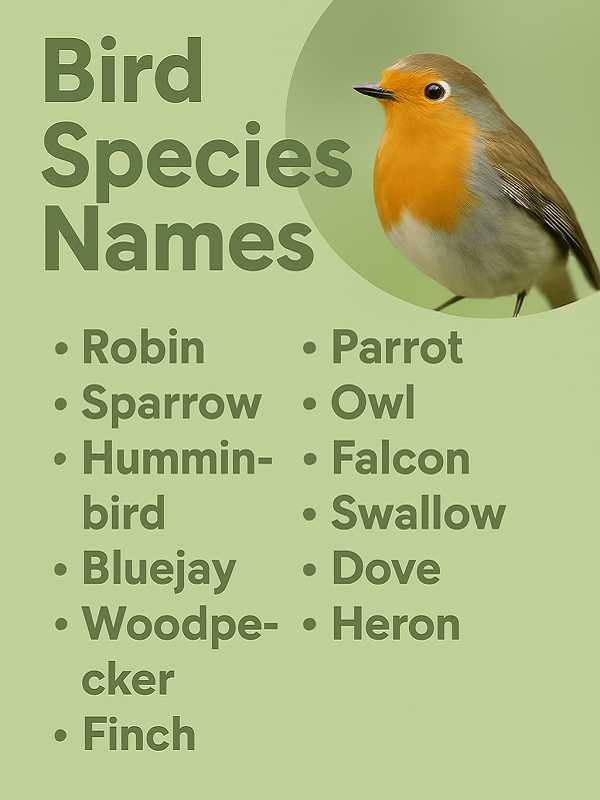
- Canorus: Melodious singing.
- Citrinus: Lemon-yellow color.
- Diurnus: Active during the day.
- Elegans: Elegant appearance.
- Fervidus: Lively, energetic.
- Gracilis: Slender build.
- Hirsutus: Bristly feathers.
- Jocosus: Playful behavior.
- Lacustris: Living by lakes.
- Nivalis: Found in snowy areas.
- Olivaceus: Olive-green color.
- Palustris: Living in marshes.
- Rapidus: Swift flight.
- Roseus: Rosy pink color.
- Saltator: Leaping movement.
- Sylvestris: Living in forests.
- Tinnulus: High-pitched call.
- Umbrinus: Dusky brown color.
- Vagans: Wandering habits.
- Xanthos: Yellow color.
- Zonatus: Banded markings.
- Aestivus: Active in summer.
- Borealis: Northern distribution.
- Caeruleus: Sky-blue color.
- Crepuscularis: Active at twilight.
- Delicatus: Delicate features.
- Fulvus: Tawny yellow color.
- Garrulus: Noisy, talkative.
- Horizonatalis: Horizontal posture.
- Indicus: Native to India.
Fish Species Names
Fish names usually come from where they live, how they look, or what they do. These names help us understand the amazing variety in the underwater world and what makes each fish stand out.
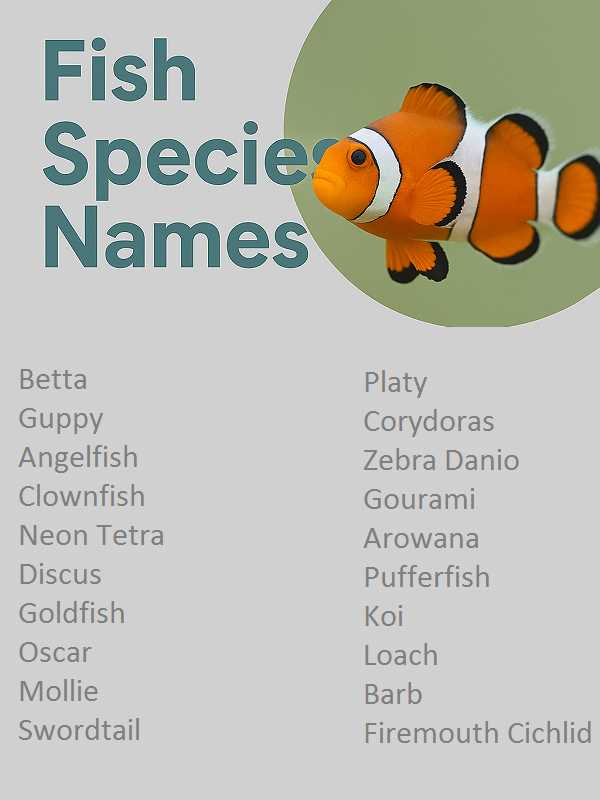
- Abyssalis: Living in the deep sea.
- Argentatus: Silvery color.
- Benthicus: Living on the sea floor.
- Caecus: Blind (no eyes).
- Cyaneus: Dark blue color.
- Fluviatilis: Living in rivers.
- Gigas: Giant size.
- Insularis: Living on islands.
- Luminosus: Bioluminescent.
- Minor: Small size.
- Niger: Black color.
- Orientalis: Found in the East.
- Piscivorus: Fish-eating.
- Rubescens: Reddish color.
- Serpentinus: Snake-like shape.
- Trutta: Trout-like.
- Urodelus: Tail fin prominent.
- Ventralis: Fins on the belly.
- Zebra: Striped markings.
- Albus: White color.
- Brachyurus: Short-tailed.
- Carnivorus: Meat-eating.
- Dorsalis: Fins on the back.
- Globosus: Round shape.
- Herbivorus: Plant-eating.
- Immaculatus: Unspotted.
- Latus: Wide body.
- Marinus: Living in the sea.
- Nebulosus: Cloudy markings.
- Occidentalis: Found in the West.
Alien Species Names
Alien names usually sound unusual and fun, matching their strange shapes or made-up home planets. These names are meant to spark your imagination and make these creatures feel real in their own weird and wonderful way.
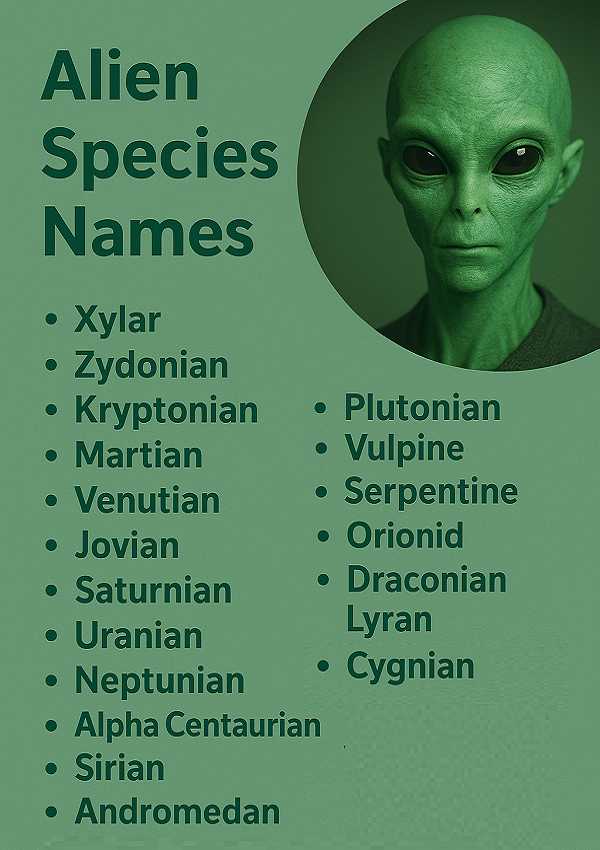
- Xylar: From planet Xylos.
- Zydonian: From planet Zydon.
- Kryptonian: From planet Krypton.
- Martian: From planet Mars.
- Venutian: From planet Venus.
- Jovian: From planet Jupiter.
- Saturnian: From planet Saturn.
- Uranian: From planet Uranus.
- Neptunian: From planet Neptune.
- Plutonian: From planet Pluto.
- Sirian: From star Sirius.
- Lyran: From constellation Lyra.
- Vulpine: Fox-like features.
- Serpentine: Snake-like form.
- Arachnid: Spider-like features.
- Avian: Bird-like traits.
- Aquaticus: Water-dwelling.
- Terrestrius: Land-dwelling.
- Volcanic: From volcanic planet.
- Glacial: From icy planet.
- Desertus: From desert planet.
- Diurnus: Active during the day.
- Parasiticus: Lives as a parasite.
- Symbioticus: Lives in symbiosis.
- Carnivorous: Meat-eating.
- Herbivorous: Plant-eating.
- Silicaceous: Silicon-based life.
- Gaseous: Living in gas giants.
- Crystalline: Crystal-based life.
- Metallic: Metal-based life.
Tree Species Names
Tree names usually come from things like the shape of their leaves, the feel of their bark, how they grow, or where they’re from. These names help us understand and appreciate the wide variety of trees around us.
- Betulifolia: Birch-like leaves.
- Carpinoides: Hornbeam-like.
- Corylifolius: Hazel-like leaves.
- Fraxinifolius: Ash-like leaves.
- Juglandifolia: Walnut-like leaves.
- Malifolia: Apple-like leaves.
- Olifolius: Olive-like leaves.
- Populifolia: Poplar-like leaves.
- Quercifolia: Oak-like leaves.
- Salicifolia: Willow-like leaves.
- Tiliifolia: Linden-like leaves.
- Ulmoides: Elm-like.
- Aceroides: Resembling maple.
- Betuloides: Resembling birch.
- Fagoides: Resembling beech.
- Quercinus: Oak-like.
- Salicinus: Willow-like.
- Tilinoides: Resembling linden.
- Alba: White bark or flowers.
- Nigra: Dark bark or leaves.
- Rubra: Reddish leaves or bark.
- Lutea: Yellow flowers or leaves.
- Glauca: Bluish-green leaves.
- Pendula: Weeping branches.
- Nana: Dwarf variety.
- Grandiflora: Large flowers.
- Microphylla: Small leaves.
- Macrophylla: Large leaves.
- Sempervirens: Evergreen.
- Decidua: Deciduous.
Flower Species Names
People often name flowers based on their color, shape, scent, or the way they grow. These names help show what makes each flower special and different.
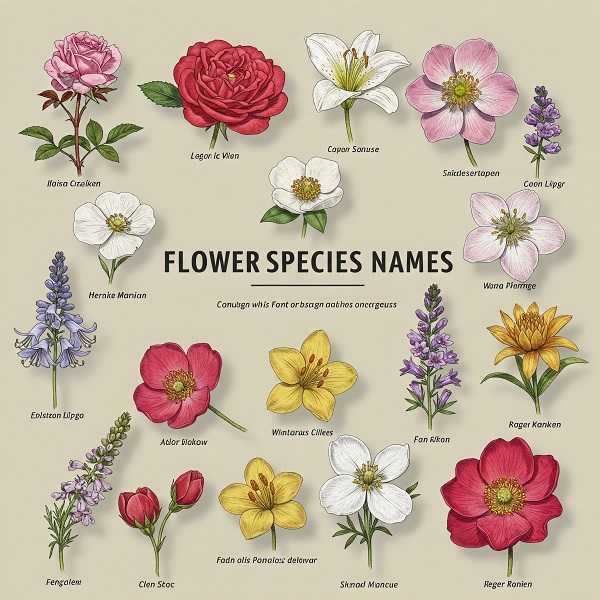
- Albusflorus: White-flowered.
- Roseiflorus: Rose-like flowers.
- Luteiflorus: Yellow-flowered.
- Rubriflorus: Red-flowered.
- Caeruleiflorus: Blue-flowered.
- Viridiflorus: Green-flowered.
- Aurantiflorus: Orange-flowered.
- Purpureiflorus: Purple-flowered.
- Grandiflorus: Large-flowered.
- Parviflorus: Small-flowered.
- Multiflorus: Many-flowered.
- Uniflorus: Single-flowered.
- Penduliflorus: Hanging flowers.
- Erectiflorus: Upright flowers.
- Globiflorus: Globe-shaped flowers.
- Tubiflorus: Tube-shaped flowers.
- Stelliflorus: Star-shaped flowers.
- Campanuliflorus: Bell-shaped flowers.
- Radiatusflorus: Rayed flowers.
- Spicatusflorus: Spike-like flowers.
- Umbelliflorus: Umbel-like flowers.
- Capitatusflorus: Head-like flowers.
- Scandensflorus: Climbing flowers.
- Repensflorus: Creeping flowers.
- Arboreusflorus: Tree-like flowers.
- Fruticosusflorus: Shrubby flowers.
- Annusflorus: Annual flowers.
- Biennisflorus: Biennial flowers.
- Perennisflorus: Perennial flowers.
- Sylvestrisflorus: Woodland flowers.
Genus Species Names
Usually, these names put together a group name with a description that points out something unique about the species. They’re the simplest way to classify and recognize different living creatures.
- Acer rubrum: Red maple.
- Quercus alba: White oak.
- Pinus nigra: Black pine.
- Rosa canina: Dog rose.
- Lilium candidum: White lily.
- Tulipa gesneriana: Common tulip.
- Bellis perennis: Common daisy.
- Salvia officinalis: Common sage.
- Thymus vulgaris: Common thyme.
- Allium sativum: Garlic.
- Solanum tuberosum: Potato.
- Oryza sativa: Rice.
- Triticum aestivum: Wheat.
- Zea mays: Corn.
- Canis lupus: Gray wolf.
- Felis catus: Domestic cat.
- Panthera leo: Lion.
- Elephas maximus: Asian elephant.
- Homo sapiens: Human.
- Apis mellifera: Western honey bee.
- Drosophila melanogaster: Fruit fly.
- Amoeba proteus: Common amoeba.
- Escherichia coli: Common gut bacterium.
- Saccharomyces cerevisiae: Baker’s yeast.
- Hydra vulgaris: Common hydra.
- Asterias rubens: Common starfish.
- Helix aspersa: Common garden snail.
- Daphnia magna: Water flea.
- Planaria torva: Flatworm.
- Caenorhabditis elegans: Nematode worm.
Animal Species Names
These names often describe distinctive physical traits, behaviors, or habitats of various animal species. These names aim to capture the diverse animal kingdom.
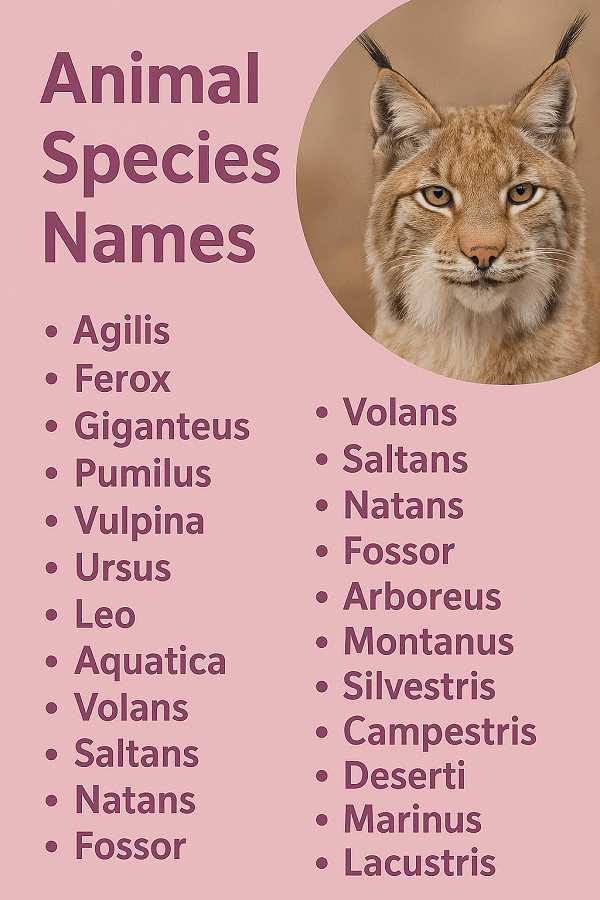
- Agilis: Agile movement.
- Ferox: Fierce nature.
- Giganteus: Giant size.
- Pumilus: Dwarf size.
- Vulpina: Fox-like.
- Ursus: Bear-like.
- Leo: Lion-like.
- Aquatica: Water-dwelling.
- Volans: Flying.
- Saltans: Leaping.
- Natans: Swimming.
- Fossor: Burrowing.
- Arboreus: Tree-dwelling.
- Montanus: Mountain-dwelling.
- Silvestris: Forest-dwelling.
- Campestris: Field-dwelling.
- Deserti: Desert-dwelling.
- Marinus: Sea-dwelling.
- Lacustris: Lake-dwelling.
- Fluviatilis: River-dwelling.
- Nocturnus: Active at night.
- Diurnus: Active during the day.
- Migratorius: Migratory habits.
- Sedentarius: Sedentary habits.
- Carnivorus: Meat-eating.
- Herbivorus: Plant-eating.
- Omnivorus: Eats both.
- Piscivorus: Fish-eating.
- Insectivorus: Insect-eating.
- Frugivorus: Fruit-eating.
Bee Species Names
Bee names usually come from their appearance, where they live, or the flowers they like. These names help us understand the many kinds of bees out there.
- Bombiformis: Bumblebee-like.
- Ceratina: Waxy nests.
- Colletes: Glue-producing.
- Dasypoda: Hairy legs.
- Eucera: Long antennae.
- Hylaeus: Masked bees.
- Megachile: Leaf-cutter bees.
- Nomada: Cuckoo bees.
- Osmia: Mason bees.
- Peponapis: Squash bees.
- Prosopis: Yellow-faced bees.
- Rhophites: Clover specialists.
- Xylocopa: Carpenter bees.
- Anthophora: Digger bees.
- Bombus: Bumblebees.
- Apis: True honey bees.
- Melipona: Stingless bees.
- Augochlora: Small metallic bees.
- Dialictus: Small sweat bees.
- Andrena: Solitary ground-nesting bees.
- Hoplitis: Horn-faced bees.
- Chelostoma: Scissor bees.
- Anthidium: Wool carder bees.
- Dioxys: Cuckoo resin bees.
- Thyreus: Cuckoo jewel bees.
- Centris: Oil-collecting bees.
- Eulaema: Robust orchid bees.
- Exomalopsis: Small, fast bees.
- Hesperapis: Evening-flying bees.
- Triepeolus: Cuckoo long-horned bees.
Stellaris Species Names
Names like these are often inspired by stars, constellations, or space. They’re commonly used in sci-fi and fantasy to name aliens or creatures that feel like they come from another world.
- Astron: Star-like.
- Cosmica: From the cosmos.
- Stella: Star.
- Lunaris: Moon-like.
- Solaris: Sun-like.
- Cometa: Comet-like.
- Planeta: Planet-like.
- Siriusa: From star Sirius.
- Vega: From star Vega.
- Altaira: From star Altair.
- Rigela: From star Rigel.
- Antaresia: From star Antares.
- Capella: From star Capella.
- Polluxia: From star Pollux.
- Castora: From star Castor.
- Deneba: From star Deneb.
- Lyrae: From constellation Lyra.
- Draconis: From constellation Draco.
- Cygnia: From constellation Cygnus.
- Ursae: From constellation Ursa.
- Triangulia: From Triangulum galaxy.
- Magellanica: From Magellanic Clouds.
- Quasara: From a quasar.
- Pulsara: From a pulsar.
- Supernova: From a supernova.
- Exoplaneta: From an exoplanet.
- TerraNova: New Earth-like.
- Alpha: First star.
- Beta: Second star.
- Gamma: Third star.
Snake Species Names
Snake names usually come from their color, size, where they live, or if they’re venomous. These names help show the wide variety of snakes and what makes each one different.

- Atrox: Deadly venomous.
- Constrictor: Squeezing prey.
- Elegans: Elegant appearance.
- Fuliginosus: Sooty black color.
- Giganteus: Very large size.
- Hortulanus: Garden-dwelling.
- Immaculatus: Unspotted.
- Juvenilis: Small, young.
- Lacunosus: Pitted scales.
- Maculatus: Spotted.
- Niger: Black color.
- Prasinus: Green color.
- Quadrivirgatus: Four stripes.
- Rubidus: Reddish color.
- Stenurus: Slender tail.
- Tigrinus: Tiger-striped.
- Undulatus: Wavy markings.
- Venomatus: Venomous.
- Xanthogaster: Yellow belly.
- Zosterops: Banded eyes.
- Agilis: Agile movement.
- Brevicaudus: Short tail.
- Corallinus: Coral-colored.
- Dorsalis: Markings on the back.
- Fasciatus: Banded markings.
- Gracilis: Slender body.
- Halophilus: Salt-tolerant.
- Insularis: Island-dwelling.
- Luteus: Yellow color.
- Minor: Small size.
Spider Species Names
Spider names usually come from their size, colors, the way they build webs, or where they live. These names help show just how different and interesting spiders can be.
- Arborealis: Tree-dwelling.
- Cursorius: Running spiders.
- Fossorius: Burrowing spiders.
- Natatorius: Swimming spiders.
- Retiarius: Net-casting spiders.
- Territorialis: Territorial behavior.
- Venatorius: Hunting spiders.
- Vagrans: Wandering spiders.
- Albovittatus: White-striped.
- Atratus: Black color.
- Bicoloratus: Two-colored.
- Chrysogaster: Golden belly.
- Cyanogaster: Blue belly.
- Auricomus: Golden hair.
- Caeruleus: Blue color.
- Coccineus: Scarlet color.
- Cupreus: Copper color.
- Ferrugineus: Rusty color.
- Griseovittatus: Gray-striped.
- Luteovittatus: Yellow-striped.
- Purpureovittatus: Purple-striped.
- Roseovittatus: Pink-striped.
- Lineatus: Striped.
- Annulatus: Ringed.
- Marginatus: Bordered.
- Punctatus: Dotted.
- Quadratus: Squared markings.
- Triguttatus: Three-spotted.
- Unimaculatus: One-spotted.
- Bimaculatus: Two-spotted.
Conclusion
No matter if you’re naming a real creature, making one up for a story, or just enjoying the wonders of nature, species names say a lot. From animals and trees to aliens and space stuff, these names are here to help you get creative. Pick the ones that feel right, have fun with them, and give your species a name that stands out.
FAQs
What makes a good species name?
A good species name reflects the creature’s characteristics, behavior, origin, or unique traits. It can be scientific (like a Latin genus/species name) or creative for fantasy and fictional settings.
Can I use these species names in my book or game?
Yes! Many of the names provided are ideal for creative use in stories, games, or world-building projects—especially categories like alien species or Stellaris species names.
Are there real scientific species names included?
Yes. Our article includes examples of genus and species names as used in biology, offering a touch of realism for educational use or science-inspired creativity.
What if I want a name for a tree, flower, or bee species?
No problem! We’ve included dedicated sections for tree species names, flower species names, and bee species names so you can find a fitting name based on beauty, function, or symbolism.
I'm the Owner of Namesnick.com. I've spent years creating fun, clever, and meaningful names for pets, characters, and anything imaginable. Naming things isn't just a job for me — I genuinely enjoy it. I like the challenge of finding that one name that feels just right. No shortcuts, no copy-paste lists. Every name I create has thought behind it, and I try to keep things fresh, original, and real. I've done my job if a name makes someone smile or feels like a perfect fit.







